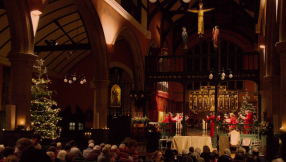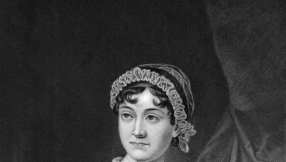
In the service held at Westminster Abbey on 11 March to mark Commonwealth Day, 11 representatives of other 'faith communities' were present alongside the representatives of the Christian churches, and at the end of the service blessings were offered for the Commonwealth on behalf of the Hindu, Jewish, Jain and Muslim communities as well as on behalf of the Church. This reminds us of the fact that we live in a world in which there are a variety of different religions and the question which this fact raises is why this is the case.
The Bible tells us that the original religion of humanity was the worship of the one creator God described in Genesis 1 and 2, the God who subsequently revealed himself to Israel as Yahweh, or in English versions of the Bible 'the Lord.' It was this God, who had made himself known by means of personal revelation to the first ancestors of the human race (Genesis 1:26-30, 2:15-24, 3:8-19, 4:1-7) who was worshipped when corporate worship was instituted in the time of Seth (Genesis 4:26).
In the nineteenth century this picture of the origin of religion came to be widely rejected by Westerns scholars. They contended that religion was a purely human construct that had gradually evolved as part of the general development of human culture, with the religion of early human cultures being primitive and polytheistic, and monotheism being a late development which emerged as a reaction against this primal polytheism.
In Western secular culture this understanding of human religious development has something that 'everybody knows.' However, it does not do justice to the discoveries about the religious beliefs and practices of indigenous peoples around the world made by students of ethnography from the nineteenth century onwards. Such peoples have cultures which preserve elements of early human culture that predate developments in later and more sophisticated cultures, and when their religions have been studied it has become clear time after time that their religions are marked by an awareness of the existence of a single, good, creator god.
In addition to the evidence provided by the cultures of indigenous peoples, scholars also found evidence for an original belief in one god by studying the later development of language and culture around the world. For example, as Robert Brow notes, study of the Indo-European language group shows an awareness of the one creator God among all the Indo-European peoples: "His first name was Dyaus Pitar ('divine father') which is the same as the Greek Zeus Pater, the Latin Jupiter or Deus, the early German Tiu or Ziu and Norse Tyr. Another name was 'the heavenly one' (Sanskrit varuna, Greek ouranos) , or 'the friend' (Sanskrit mitra, Persian mithra). By metaphor and simile other names were added. God is called 'the sun,' 'the powerful one' and 'the guardian of order.'"
The peoples involved eventually became polytheistic, but the linguistic evidence for an original monotheism remains.
In similar fashion, the evidence from China indicates that the earliest form of Chinese religion that we know about involved the worship of the one supreme sky-god known as Shang-Ti or Hao-Tien. As Chinese religion developed, the worship of Shang-Ti faded into the background, but sacrifice was offered to him three times a year by the Chinese Emperor right until the end of Imperial China in 1911.
These kind of examples of evidence for primeval monotheism from all round the world were compiled by the Scottish scholar Andrew Lang in his book The Making of Religion, first published in 1898, and were then set out in exhaustive detail by the Austrian Catholic scholar Wilhelm Schmidt in the 11,000 pages of his twelve volume study, The Origin of the Idea of God, which was published from 1912 onwards. Further study since their time has confirmed rather than overthrown their findings. The evidence of historical, ethnographic, and linguistic study confirms the biblical idea that the original religion of mankind was the worship of one creator god.
The existence of this evidence raises the issue of the ultimate origin of this religion. We know it existed, but why did it exist? As we have seen, the biblical answer is that God revealed himself personally to the earliest human beings, and this biblical answer is supported by the ethnographical evidence which time after time says that the first ancestor(s) of the people in question learned about God from God, and then passed this information on to their subsequent descendants.
To quote Schmidt: "The bottom line is that the reports we have from the adherents of the oldest religions themselves are not only merely disinclined towards the supposition that the religions were created by seeking and searching human beings; rather, worse yet, they do not even mention it with a single word. All their affirmative responses are directed to the side of divine revelation: it is God Himself Who taught humans what to believe about Him, how to venerate Him, and how they should obey the expression of His will."
If the evidence shows that the earliest religion of humankind was monotheism based on direct divine revelation, then why is there the diversity of religions and philosophies that we see today. What happened?
The answer seems to be that the present state of affairs emerged in several stages.
First, there was the emergence of polytheism, a development which saw the one god of monotheism become part of a pantheon of different divine beings. Thus, Zeus, the divine father, was still worshipped, but became only one among a range of Greek deities and the same was true of Tyr who ended up as a fairly minor Norse deity. Alongside this development there was also the development of idolatry as both people (such as the Egyptian Pharaohs), and created objects, such as statues, came to be seen as the places where the gods manifested themselves on earth, and therefore became the objects of worship in their own right.
Secondly, in the sixth century BC there was what has been described as the 'axial age,' a time which saw the emergence of Vedanta Hinduism, Buddhism and Jainism in India, Zoroastrianism in Persia, and Confucianism and Taoism in China.
These religions all seem to have emerged as a result of a revolt against the religious teaching, and also the economic and political power, of the priesthoods of the existing polytheistic religions in India, China and Persia. They introduced a range of different religious ideas and practices, but none of them marked a return to a simple creational monotheism. Instead, these new forms of religion were marked by pantheism, atheism, or agnosticism, or, in the case of Zoroastrianism, a dualism between the good creator god Ahura Mazda and the co-equal and co-eternal evil deity Ahura Mainyu.
This sixth century revolt against polytheistic religion also seems to have sparked off the revolt against polytheistic forms of religion which can be found in Greek and later Roman philosophy, a revolt which, while challenging existing forms of Greek and Roman religion, once again failed to produce a return to creational monotheism.
Finally, Islam, which may have had its roots in ancient Arabian monotheism, and was influenced by Judaism and Christianity, emerged in the seventh century AD as an uncompromisingly monotheistic reaction against Arabian polytheism and in the fifteenth century AD Sikhism emerged as a monotheistic development of the Hindu tradition.
This leaves us with Judaism and Christianity. To understand their emergence, we need to note that both the Christian faith, and a range of primeval religious traditions from around the world, bear witness to the fact that the creative activity of the single good creator God has been undermined by the work of an evil spiritual power, with the result that the world as it now exists is not how it was originally meant to be.
What the Bible tells us is that in order to rectify the disharmony introduced into his good creation by this evil power (what Christian theology calls the Devil), the creator God revealed himself to Abraham and established a covenant relationship with him and his descendants (the people of Israel) through which all the families of the earth would be blessed (Genesis 12:1-3).
The Old Testament then tells us that this same creator God subsequently appeared to Moses at the burning bush (Exodus 3:13-15, 6:2-4), rescued the people of Israel from Egypt, and established them in the land that he had promised Abraham that he would give them. The rest of the Old Testament is the story of how this God maintained his relationship with the people of Israel in spite of their constant rebellion against him, and how he spoke to them through a series of prophets who warned them to worship God alone and to live in obedience to God's laws, and who also promised that God would act in a new way to fulfil the promise of universal blessing made to Abraham.
The New Testament tells the story of how this promise was fulfilled. The creator God took human nature upon himself in the person of Jesus Christ (John 1:1-18, Hebrews 1:1-14). This began a process of cosmic renewal through Christ's death and resurrection and the pouring out of the Holy Spirit on the day of Pentecost (Romans 8:1-25), a process which will culminate in the coming of a 'new heaven and a new earth' (Revelation 21:1), Here God's people, drawn from all the nations of the earth will dwell with him forever, and 'death shall be no more, neither shall there be mourning nor crying nor pain any more, for the former things have passed away (Revelation 21:4).
The distinction between Christianity and Judaism is that Christians accept the New Testament witness that God's promises have been (and will be) fulfilled in Christ whereas adherents of Judaism do not.
From the Christian perspective the evidence summarized above means that the answer to the question of why there are a variety of religions is a story of degeneration and regeneration. It is a story of degeneration in that it tells how the knowledge of the one creator God has gradually become lost during the course of human history. It is a story of regeneration in that it tells how God has acted to restore and deepen this knowledge through the history of Israel, the incarnation of Jesus Christ, and the work of the Spirit, as part of his overall regeneration of the created order in the face of its corruption by the activity of the Devil and the human alienation from God that has resulted from it.













